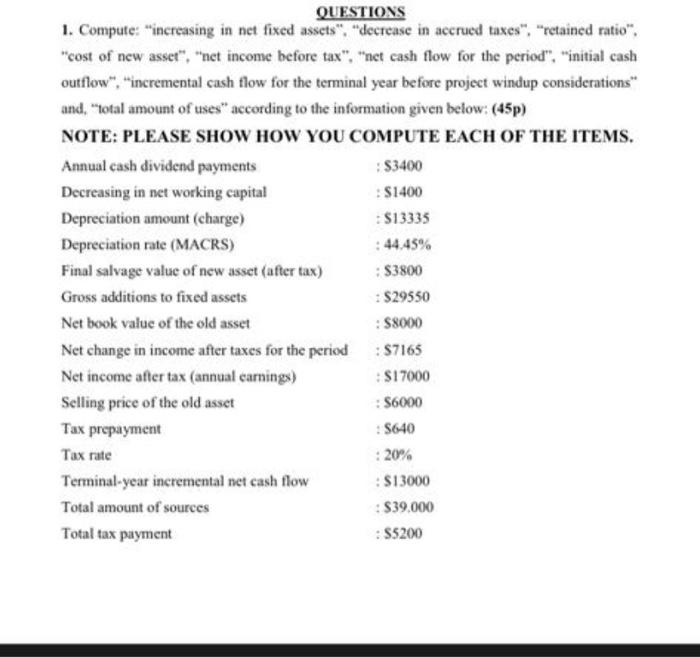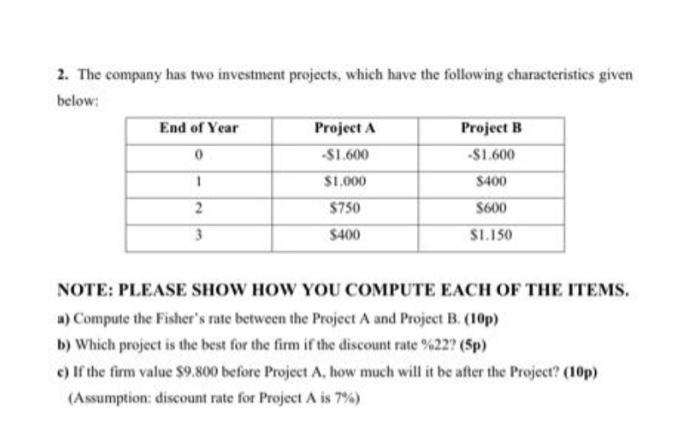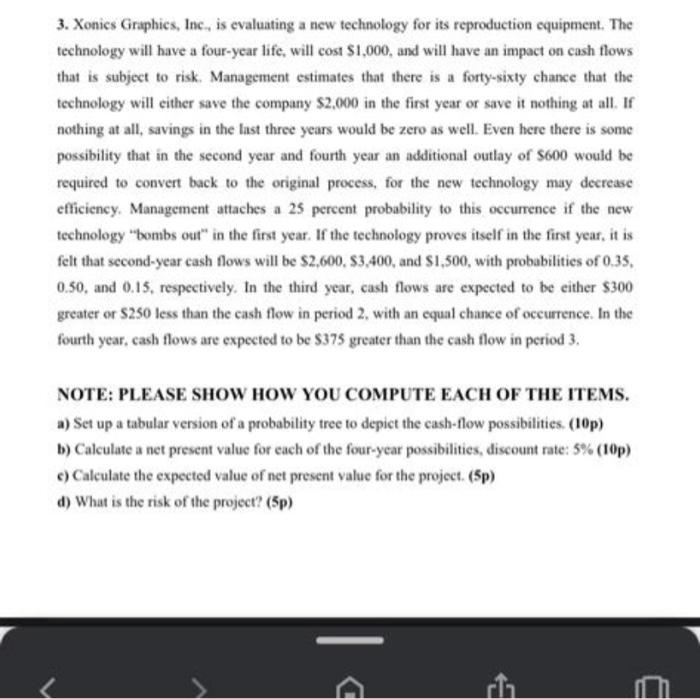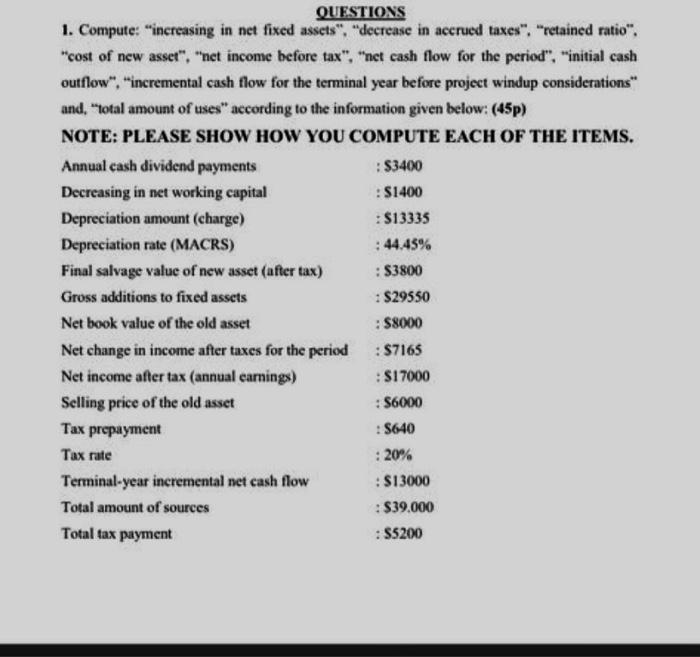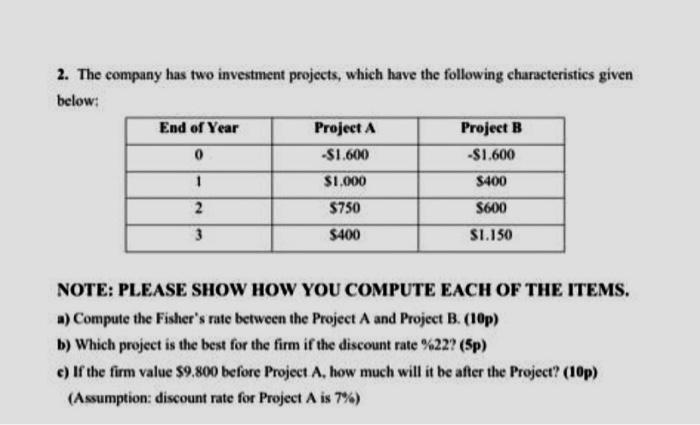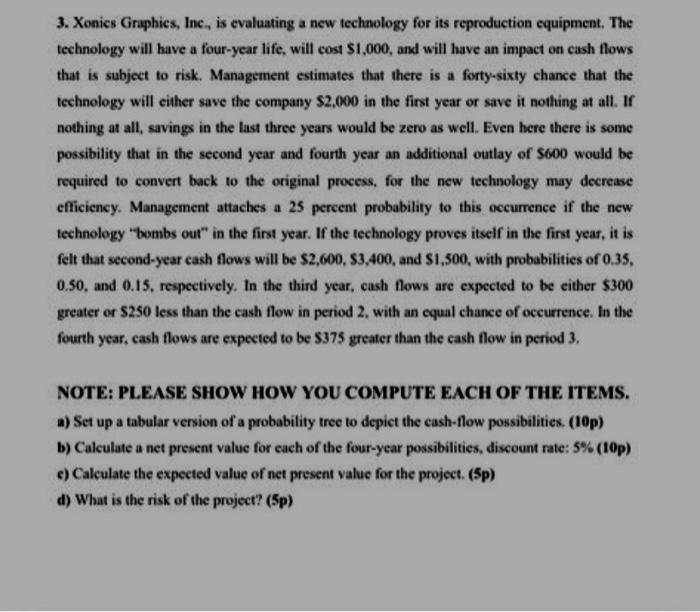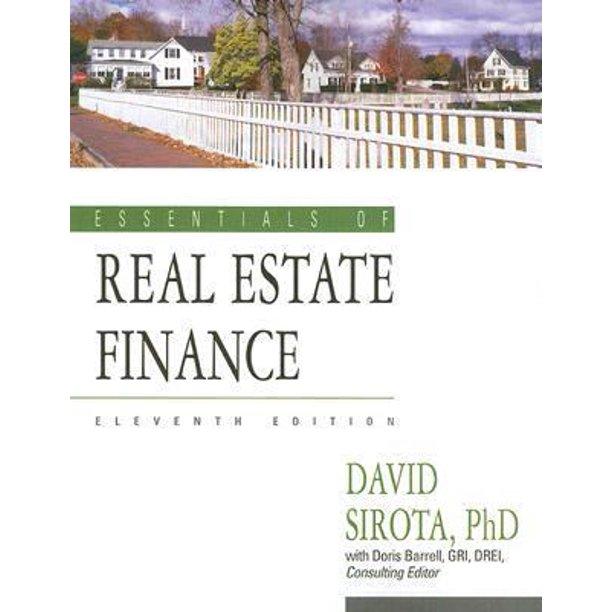QUESTIONS 1. Compute: "increasing in net fixed assets", "decrease in accrued taxes": "retained ratio. "cost of new asset", "net income before tax", "net cash flow for the period", "initial cash outflow", "incremental cash flow for the terminal year before project windup considerations" and "total amount of uses" according to the information given below: (45p) NOTE: PLEASE SHOW HOW YOU COMPUTE EACH OF THE ITEMS. Annual cash dividend payments $3400 Decreasing in net working capital :S1400 Depreciation amount (charge) S13335 Depreciation rate (MACRS) : 44.45% Final salvage value of new asset (after tax) S3800 Gross additions to fixed assets S29550 Net book value of the old asset S8000 Net change in income after taxes for the period : 87165 Net income after tax (annual earnings) S17000 Selling price of the old asset S6000 Tax prepayment S640 Tax rate : 20% Terminal-year incremental net cash flow S13000 Total amount of sources S39.000 Total tax payment : 55200 2. The company has two investment projects, which have the following characteristics given below: End of Year Project A Project B 0 -$1.600 -$1.600 1 $1.000 $400 2 $750 S600 $400 S1.150 NOTE: PLEASE SHOW HOW YOU COMPUTE EACH OF THE ITEMS. a) Compute the Fisher's rate between the Project A and Project B. (10p) b) Which project is the best for the firm if the discount rate %22? (5p) c) If the firm value 59.800 before Project A, how much will it be after the Project? (10p) (Assumption: discount rate for Project A is 7%) 3. Xonics Graphics, Inc., is evaluating a new technology for its reproduction equipment. The technology will have a four-year life, will cost $1,000, and will have an impact on cash flows that is subject to risk. Management estimates that there is a forty-sixty chance that the technology will either save the company $2,000 in the first year or save it nothing at all. If nothing at all, savings in the last three years would be zero as well. Even here there is some possibility that in the second year and fourth year an additional outlay of S600 would be required to convert back to the original process, for the new technology may decrease efficiency, Management attaches a 25 percent probability to this occurrence if the new technology bombs out" in the first year. If the technology proves itself in the first year, it is felt that second-year cash flows will be $2,600, $3,400, and $1,500, with probabilities of 0.35, 0.50, and 0.15, respectively. In the third year, cash flows are expected to be either $300 greater or $250 less than the cash flow in period 2, with an equal chance of occurrence. In the fourth year, cash flows are expected to be $375 greater than the cash flow in period 3. NOTE: PLEASE SHOW HOW YOU COMPUTE EACH OF THE ITEMS. a) Set up a tabular version of a probability tree to depict the cash-flow possibilities. (10p) b) Calculate a net present value for each of the four-year possibilities, discount rate: 5% (10p) c) Calculate the expected value of net present value for the project. (5p) d) What is the risk of the project? (5p) A rta QUESTIONS 1. Compute: "increasing in net fixed assets", "decrease in accrued taxes". "retained ratio". "cost of new asset", "net income before tax", "net cash flow for the period", "initial cash outflow", "incremental cash flow for the terminal year before project windup considerations and total amount of uses according to the information given below: (45p) NOTE: PLEASE SHOW HOW YOU COMPUTE EACH OF THE ITEMS. Annual cash dividend payments : $3400 Decreasing in net working capital S1400 Depreciation amount (charge) : $13335 Depreciation rate (MACRS) : 44.45% Final salvage value of new asset (after tax) : S3800 Gross additions to fixed assets S29550 Net book value of the old asset : 58000 Net change in income after taxes for the period : $7165 Net income after tax (annual earnings) :S17000 Selling price of the old asset : S6000 Tax prepayment :S640 Tax rate 20% Terminal-year incremental net cash flow : S13000 Total amount of sources : $39.000 Total tax payment : 55200 2. The company has two investment projects, which have the following characteristics given below: End of Year Project A Project B 0 -$1.600 -$1.600 1 $1.000 $400 2 $750 S600 $400 S1.150 NOTE: PLEASE SHOW HOW YOU COMPUTE EACH OF THE ITEMS. a) Compute the Fisher's rate between the Project A and Project B. (10p) b) Which project is the best for the firm if the discount rate %22? (5p) c) If the firm value $9.800 before Project A, how much will it be after the Project? (10p) (Assumption: discount rate for Project A is 7%) 3. Xonics Graphics, Inc. is evaluating a new technology for its reproduction equipment. The technology will have a four-year life, will cost $1,000, and will have an impact on cash flows that is subject to risk. Management estimates that there is a forty-sixty chance that the technology will either save the company S2.000 in the first year or save it nothing at all. If nothing at all, savings in the last three years would be zero as well. Even here there is some possibility that in the second year and fourth year an additional outlay of S600 would be required to convert back to the original process, for the new technology may decrease efficiency. Management attaches a 25 percent probability to this occurrence if the new technology "bombs out in the first year. If the technology proves itself in the first year, it is felt that second-year cash flows will be $2,600, $3,400, and $1,500, with probabilities of 0.35, 0.50, and 0.15, respectively. In the third year, cash flows are expected to be either $300 greater or S250 less than the cash flow in period 2. with an equal chance of occurrence. In the fourth year, cash flows are expected to be $375 greater than the cash flow in period 3. NOTE: PLEASE SHOW HOW YOU COMPUTE EACH OF THE ITEMS. a) Set up a tabular version of a probability tree to depict the cash-flow possibilities. (10p) b) Calculate a net present value for each of the four-year possibilities, discount rate: 5% (10p) c) Calculate the expected value of net present value for the project. (5p) d) What is the risk of the project? (5p) QUESTIONS 1. Compute: "increasing in net fixed assets", "decrease in accrued taxes": "retained ratio. "cost of new asset", "net income before tax", "net cash flow for the period", "initial cash outflow", "incremental cash flow for the terminal year before project windup considerations" and "total amount of uses" according to the information given below: (45p) NOTE: PLEASE SHOW HOW YOU COMPUTE EACH OF THE ITEMS. Annual cash dividend payments $3400 Decreasing in net working capital :S1400 Depreciation amount (charge) S13335 Depreciation rate (MACRS) : 44.45% Final salvage value of new asset (after tax) S3800 Gross additions to fixed assets S29550 Net book value of the old asset S8000 Net change in income after taxes for the period : 87165 Net income after tax (annual earnings) S17000 Selling price of the old asset S6000 Tax prepayment S640 Tax rate : 20% Terminal-year incremental net cash flow S13000 Total amount of sources S39.000 Total tax payment : 55200 2. The company has two investment projects, which have the following characteristics given below: End of Year Project A Project B 0 -$1.600 -$1.600 1 $1.000 $400 2 $750 S600 $400 S1.150 NOTE: PLEASE SHOW HOW YOU COMPUTE EACH OF THE ITEMS. a) Compute the Fisher's rate between the Project A and Project B. (10p) b) Which project is the best for the firm if the discount rate %22? (5p) c) If the firm value 59.800 before Project A, how much will it be after the Project? (10p) (Assumption: discount rate for Project A is 7%) 3. Xonics Graphics, Inc., is evaluating a new technology for its reproduction equipment. The technology will have a four-year life, will cost $1,000, and will have an impact on cash flows that is subject to risk. Management estimates that there is a forty-sixty chance that the technology will either save the company $2,000 in the first year or save it nothing at all. If nothing at all, savings in the last three years would be zero as well. Even here there is some possibility that in the second year and fourth year an additional outlay of S600 would be required to convert back to the original process, for the new technology may decrease efficiency, Management attaches a 25 percent probability to this occurrence if the new technology bombs out" in the first year. If the technology proves itself in the first year, it is felt that second-year cash flows will be $2,600, $3,400, and $1,500, with probabilities of 0.35, 0.50, and 0.15, respectively. In the third year, cash flows are expected to be either $300 greater or $250 less than the cash flow in period 2, with an equal chance of occurrence. In the fourth year, cash flows are expected to be $375 greater than the cash flow in period 3. NOTE: PLEASE SHOW HOW YOU COMPUTE EACH OF THE ITEMS. a) Set up a tabular version of a probability tree to depict the cash-flow possibilities. (10p) b) Calculate a net present value for each of the four-year possibilities, discount rate: 5% (10p) c) Calculate the expected value of net present value for the project. (5p) d) What is the risk of the project? (5p) A rta QUESTIONS 1. Compute: "increasing in net fixed assets", "decrease in accrued taxes". "retained ratio". "cost of new asset", "net income before tax", "net cash flow for the period", "initial cash outflow", "incremental cash flow for the terminal year before project windup considerations and total amount of uses according to the information given below: (45p) NOTE: PLEASE SHOW HOW YOU COMPUTE EACH OF THE ITEMS. Annual cash dividend payments : $3400 Decreasing in net working capital S1400 Depreciation amount (charge) : $13335 Depreciation rate (MACRS) : 44.45% Final salvage value of new asset (after tax) : S3800 Gross additions to fixed assets S29550 Net book value of the old asset : 58000 Net change in income after taxes for the period : $7165 Net income after tax (annual earnings) :S17000 Selling price of the old asset : S6000 Tax prepayment :S640 Tax rate 20% Terminal-year incremental net cash flow : S13000 Total amount of sources : $39.000 Total tax payment : 55200 2. The company has two investment projects, which have the following characteristics given below: End of Year Project A Project B 0 -$1.600 -$1.600 1 $1.000 $400 2 $750 S600 $400 S1.150 NOTE: PLEASE SHOW HOW YOU COMPUTE EACH OF THE ITEMS. a) Compute the Fisher's rate between the Project A and Project B. (10p) b) Which project is the best for the firm if the discount rate %22? (5p) c) If the firm value $9.800 before Project A, how much will it be after the Project? (10p) (Assumption: discount rate for Project A is 7%) 3. Xonics Graphics, Inc. is evaluating a new technology for its reproduction equipment. The technology will have a four-year life, will cost $1,000, and will have an impact on cash flows that is subject to risk. Management estimates that there is a forty-sixty chance that the technology will either save the company S2.000 in the first year or save it nothing at all. If nothing at all, savings in the last three years would be zero as well. Even here there is some possibility that in the second year and fourth year an additional outlay of S600 would be required to convert back to the original process, for the new technology may decrease efficiency. Management attaches a 25 percent probability to this occurrence if the new technology "bombs out in the first year. If the technology proves itself in the first year, it is felt that second-year cash flows will be $2,600, $3,400, and $1,500, with probabilities of 0.35, 0.50, and 0.15, respectively. In the third year, cash flows are expected to be either $300 greater or S250 less than the cash flow in period 2. with an equal chance of occurrence. In the fourth year, cash flows are expected to be $375 greater than the cash flow in period 3. NOTE: PLEASE SHOW HOW YOU COMPUTE EACH OF THE ITEMS. a) Set up a tabular version of a probability tree to depict the cash-flow possibilities. (10p) b) Calculate a net present value for each of the four-year possibilities, discount rate: 5% (10p) c) Calculate the expected value of net present value for the project. (5p) d) What is the risk of the project? (5p)
